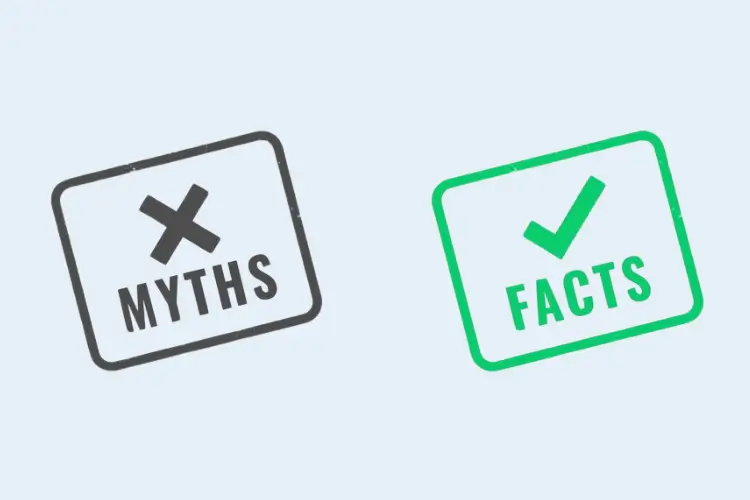Regarding bike insurance, misinformation can cost you more than just money. From assuming third-party cover is enough to believing you can only claim once a year, these common myths can leave riders underinsured or misinformed.
In this blog, we’re busting six popular misconceptions and shedding light on what truly matters so you can ride smarter, safer, and fully protected.
7 Common Myths About Bike Insurance
Here are six common myths many bikers believe, and let’s separate fact from fiction.
1. Third-Party Cover is Usually Enough
Reality: It’s mandatory but not always sufficient.
Third-party insurance covers only the other person in an accident, not your bike. A comprehensive bike insurance plan is the way to go if you’re looking for complete protection.
What you get with comprehensive cover:
A comprehensive bike insurance plan provides wider coverage, going beyond just third-party liability to protect you and your vehicle more effectively. Here’s what you can typically expect under this plan:
- Coverage for own damage
- Theft and natural calamity protection
- Personal accident cover
2. You are Allowed to Claim Only Once Per Year
Reality: There’s no fixed limit, but strategy matters.
You can make multiple claims in a year. Remember that frequent claims may impact your No Claim Bonus (NCB).
Keep in mind:
- While there’s no strict limit on the number of claims you can make, it helps to be strategic. Here are a few things to keep in mind:
- Valid claims are always accepted.
- Too many claims might reduce your NCB benefits.
- It’s smart to reserve claims for larger repairs.
3. Insurance Renewals are Not Required for Older Bikes
Reality: Absolutely. Insurance is mandatory regardless of your bike’s age.
Even if your bike is a few years old, you still need an active policy to stay on the right side of the law and protect your finances.
Why should you renew insurance for older bikes?
Older bikes still need protection on the road, and renewing your insurance ensures you stay covered. Here’s why keeping it up to date matters:
- Legal requirement
- Protection against third-party liability
- Affordable renewal options are available
You may also be eligible for useful add-ons like zero depreciation bike insurance, depending on your insurer.
4. All Bike Insurance Policies are the Same
Reality: Every insurer offers unique benefits and exclusions.
Not all plans are created equal. The coverage, exclusions, premiums, and customer service can vary significantly.
Here’s a simple comparison:
| Feature | Basic (Third-Party) | Comprehensive |
| Third-party liability | Yes | Yes |
| Damage to own bike | No | Yes |
| Theft and disasters | No | Yes |
| Add-on options | No | Yes |
| Personal accident cover | Yes | Yes |
Tip: Always compare not just the price but the value of the coverage.
5. Add-ons are Not Worth the Extra Cost
Reality: The right add-ons offer real value and can save you money in the long run.
Add-ons enhance your protection and make claims more efficient. One of the most useful add-ons is zero depreciation bike insurance, especially for newer bikes.
Popular and practical add-ons:
Add-ons can enhance your bike insurance policy and offer extra peace of mind. Here are some popular and practical options worth considering:
- Zero depreciation cover
- Roadside assistance
- Engine protect cover
- Return to invoice cover
6. Zero Depreciation Bike Insurance is Just a Marketing Gimmick
Reality: It’s a valuable add-on for new and high-end bikes.
Many assume zero depreciation bike insurance is unnecessary or only inflates the premium. In truth, it helps you get full compensation without depreciation deduction when making a claim.
Before opting in, consider the following:
- How many zero-depreciation claims are allowed per year
- Your bike’s age and model
- Whether you value full coverage over a slightly cheaper premium
7. Bike Insurance Covers Everything Automatically
Reality: You need to understand what’s included—and what’s not.
A common mistake riders make is assuming their insurance covers all damages or scenarios. In reality, every policy comes with specific inclusions and exclusions.
What’s often not covered unless added:
- Regular wear and tear
- Electrical or mechanical breakdowns
- Damages from riding without a valid licence or under the influence
- Using the bike for commercial purposes without proper coverage
Tip: Always read the policy document carefully and ask your insurer about optional cover if you have special requirements. Knowing in advance is better than facing surprises during a claim.
Bike insurance doesn’t have to be confusing. By avoiding common myths and understanding your options, like zero-depreciation bike insurance, you can make informed choices that better protect you on the road.
Take time to compare policies, understand what’s covered, and choose add-ons based on your needs. A well-chosen insurance plan complies with the law and gives you peace of mind every time you ride.




